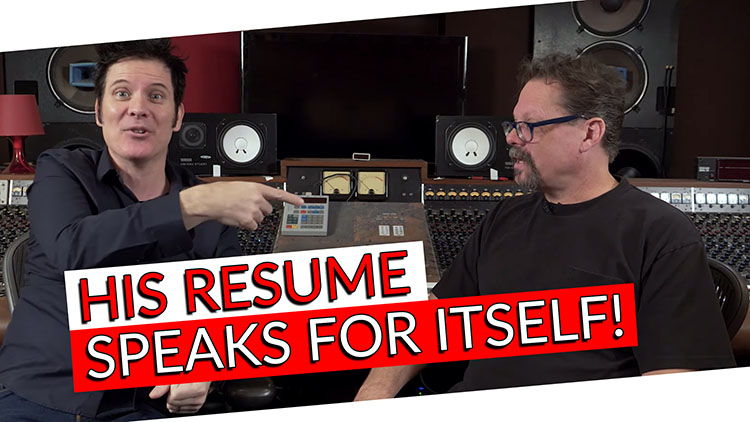Bradley Cook is an engineer who’s worked with countless amazing artists, including Foo Fighters, Queens of the Stone Age, Counting Crows, Isaac Hayes, Ben Harper, Fishbone, and Everclear. He calls Barefoot Recording a home away from home, having worked there on and off since the studio’s renovation and rebranding in 2000. Bradley assisted Eric Valentine on projects over the years, while also venturing off on major projects of his own at various studios—notably Grandmaster Recorders, which was unfortunately sold for redevelopment nearly two years ago.
Bradley brings 30 years’ experience as an audio engineer to the table, and his résumé speaks for itself!
Getting Started in the Recording Industry
When Bradley was 5 years old, he heard the Jackson 5’s “ABC” and immediately knew he wanted to make records for a living—even if he wasn’t yet able to articulate that as a child! He would grow up to study a bit of audio engineering in college before landing his first gig at a heavy metal studio in Orange County, California. Though he never finished his degree, it was never a hindrance to his career advancement. Bradley left Orange County for Hollywood and got a job at Grandmaster Recorders.
He met Sylvia Massy (Tool, System of a Down, Red Hot Chili Peppers) at Grandmaster and had a chance to work on Tool’s 1993 debut, Undertow, with her. He would then be introduced to Kevin Mills of Larrabee Sound Studios, where he would go on to assist for a stint, concurrently working at a Virgin Records studio. Much of Bradley’s prominent work was done at Grandmaster.
At Grandmaster Recorders
Ben Harper
Bradley recalls working on Ben Harper’s Fight for Your Mind at Grandmaster in the mid-90s. During a session, there was a leak in the ceiling that was audible over Harper’s softly sung vocals. The album then had to be finished at a different studio altogether!
Foo Fighters
Foo Fighter’s second album, The Colour and the Shape, was primarily recorded at Grandmaster by Bradley, alongside producer Gil Norton.
The first sessions for the album took place at Bear Creek Studios in Woodinville, Washington, which proved to be a less than fruitful experience. Bradley recalls trying to edit drums with Gil Norton, and struggling through the process. By the time the tracks got back to Los Angeles, it was evident that they should be re-recorded. Drum re-dos were handled by Dave Grohl at Grandmaster.
For this album, Bradley and the band were recording while finished tracks were being mixed by Chris Sheldon. Tracks “hot off the machine” were sent down the street to Skip Sailor Studios to be mixed. At one point, if the mixing team had a suggestion—for instance, additional chorus guitars on “Monkey Wrench”—the tracks would be sent back to Bradley for overdubs, and back once more to Skip Sailor Studios. It was practically an album assembly line!
Bradley’s Barefoot Recording & UnderTone Audio Associations
Bradley has been an integral part of the Barefoot/UnderTone Audio family from the beginning. For the latter, he serves as project manager and prototype builder!
Barefoot
Prior to becoming a renowned recording studio, Barefoot Recording was built as a post office in the early ’50s. Some time later, Andrew Berliner acquired the space, converting it into Crystal Industries Recording Studios in 1967. At the time, the studio hosted an all-star list of clients, including Jimi Hendrix, The Doors, Supertramp, Eric Clapton, and James Taylor. Most notably, perhaps, Crystal Industries is where Stevie Wonder recorded Songs in the Key of Life.
SEE ALSO:
5 Delay Mixing Tricks
Drum Mixing Basics
Mixing: Headphones Vs Monitors
In the late ’80s and early ’90s, producer Matt Hyde leased the facility to work on such projects as Jane’s Addiction and Porno for Pyros. When Eric Valentine acquired the building in 2000, major renovations were made as a restoration effort, for which Bradley was present from the start. Barefoot Recording has since hosted its own incredible list of artists over the past two decades.
UnderTone Audio
Barefoot owner Eric Valentine co-founded UnderTone Audio—a pro audio equipment design and manufacturing company. UTA notably produces the Unfairchild compressor which has previously been discussed at length!
Bradley notably works as project manager, prototype builder, and machinist at UnderTone, bringing 30 years of audio engineering experience to the team.
The UTA Console
In Studio A at Barefoot stands the LC60: the first console commissioned by UTA. It was designed and assembled at Barefoot Recording and currently holds a full-time job in Studio A making records! Eric loved it so much it lead to the production of a second console for Studio B. Eventually, so many people wanted to buy an LC60 that it lead to the production of rack gear and the making of the Unfairchild compressor. Since then, 8 more custom consoles have been built and sold.
LC60 UnderToneAudio Custom Console Specifications:
• 60 channels of UTA channel strips
• 24 busses
• 6 aux sends
• 4 additional external monitoring inputs
• Tube mix buss and control room outputs
• Analog VU metering for channels, busses, & aux sends
• Individual level & pan control on buss sends for surround mixing
• UnderTone Audio EQ on every channel
• Built-in audiophile headphone amp
• Equipped with Martinsound Flying Faders II system
